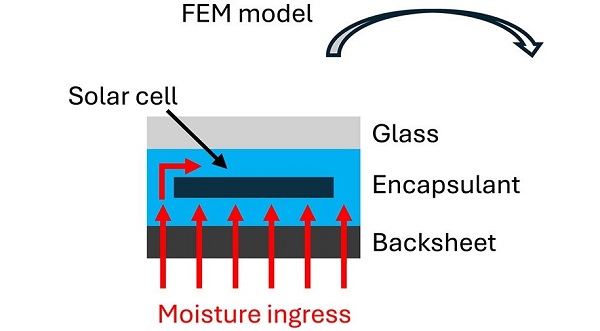Researchers in the Netherlands and Belgium have created a numerical model to simulate the moisture invading PV modules. Their research work showed that the climate in which a PV module is installed has a much higher impact on the penetration of moisture than the choice of materials for the encapsuling of the after -switching.
A research team led by TU Delft in Dutch simulated the penetration of moisture into PV modules to better understand degradation caused by humidity. They analyzed the effect of encapsuring and backsheet material choices and climate conditions.
“What is new in our work is that we have reported the relative concentration of moisture content instead of the actual concentration, because the literature suggests PV Magazine.
Indeed, one of the most important findings described in “Modeling of moisture indress in PV modules with different Encapsulant and Backsheet -Materials‘Published by Renewable energyIs that the use of relative moisture concentration (RMC) as a stress factor in breakdown models is a “better indicator” than the more usual effective relative humidity (RH).
To analyze the penetration of moisture into a PV module, the Team Devices simulated for a period of 20 years made with three different Encapsulants and four different backsheet materials and modules in eight cities in four climate zones. They used a finite element method (FEM) model built in Comsol Multiphysics. According to the investigation, it was included the second law of diffusion and the law of Henry and Henry.
The Peck model, that’s one gear model For the evaluation of temperature and humidity of moisture-induced IC failure in epoxy components, was used to calculate the normalized power through the lifespan of the module.
Image: TU Delft, Renewable Energy, Creative Commons License CC by 4.0
For Encapsulantia, the team selected Ethylene vinylacetate (EVA), thermoplastic polyolefine (TPO) and polydimethylsiloxan (PDMS). For the back shoes, polyethylene tereftalate (PET), Tedlar-Pet-Tedlar (TPT), Tedlar-Pet-SioX (TPSIX) and Polyamide (PA) were selected. Their qualities were obtained from published sources.
The reference -PV module used EVA as the encapsulating and cap as afterwards.
Eight cities were grouped in four climate zones: tropical represented by Manaus, Brazil and Jakarta, Indonesia; moderately represented by Los Angeles, US and Freiburg, Germany; Dry represented by Dubai, VAE and Almeria, Spain; and continental represented by Portland, US and Oslo, Norway.
The scientists validated the model with indoor experiments and outside simulations from the literature.
“In our research we found that the climate in which a PV module is installed has a much higher impact on the penetration of moisture than the choice of materials for the encapsulant of the afterwards,” said Blom. “This suggests that it can be useful to have different PV module designs designed for specific climates, rather than one worldwide solution design.”
The researchers then developed a “simple analytical comparison that can be used to predict the moisture input” without trusting time -consuming and computational intense simulations. “This comparison contains only four unknown parameters that can be obtained from the climate conditions of the installed location,” Blom explains.
The less computational intense analytical model used empirical parameters derived from the FEM simulations and achieved an accuracy deviation of less than 0.05. The researchers concluded that the moisture input can effectively predict in new locations without resorting to computational intensive FEM simulations.
“Het was verrassend om te zien dat alle kenmerken die ook in het eenvoudige analytische model worden gebruikt, nauwkeurig kunnen worden uitgerust met een lineaire trend met betrekking tot een specifieke stressfactor. Dit was een belangrijke stap in de ontwikkeling van het analytische model, omdat het ons in staat stelt om deze kenmerken te voorspellen voor nieuwe locaties zonder de simulatie te maken, niet-simulatie, andere simulaties, andere simulaties, andere simulaties en hun gevolgen voor het plannen of the lifetime of life, other simulations and their consequences for planning the lifetime of life and their consequences for planning the lifetime of life and their consequences for planning the lifetime of life, different relegation mechanism, and their consequences for the feeling of another simulations, pvmod.
Researchers from the IMEC of Belgium, Hasselt University and Energeville have contributed to the research.
This content is protected by copyright and may not be reused. If you want to work with us and reuse part of our content, please contact: editors@pv-magazine.com.
Popular content


